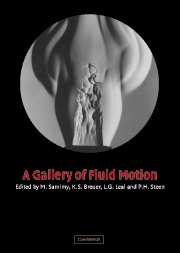6 - Flows with interfaces
Published online by Cambridge University Press: 25 January 2010
Summary
We examine the form of the free surface flows resulting from the collision of equal jets at an oblique angle. Glycerol-water solutions with viscosities of 15–50 cS were pumped at flow rates of 10–40 cc/s through circular outlets with diameter 2 mm. Characteristic flow speeds are 1–3 m/s. Figures 2–4 were obtained through strobe illumination at frequencies in the range 2.5–10 kHz.
At low flow rates, the resulting stream takes the form of a steady fluid chain, a succession of mutually orthogonal fluid links, each comprised of a thin oval sheet bound by relatively thick fluid rims (Fig. 1). The influence of viscosity serves to decrease the size of successive links, and the chain ultimately coalesces into a cylindrical stream.
As the flow rate is increased, waves are excited on the sheet, and the fluid rims become unstable (Figs. 2 and 3). Droplets form from the sheet rims but remain attached to the fluid sheet by tendrils of fluid that thin and eventually break. The resulting flow takes the form of fluid fishbones, with the fluid sheet being the fish head and the tendrils its bones. Increasing the flow rate serves to broaden the fishbones.
In the wake of the fluid fish, a regular array of drops obtains, the number and spacing of which is determined by the pinch–off of the fishbones (Fig. 4). At the highest flow rates examined, the flow is reminiscent of that arising in acoustically excited fan-spray nozzles.
- Type
- Chapter
- Information
- A Gallery of Fluid Motion , pp. 63 - 71Publisher: Cambridge University PressPrint publication year: 2004



